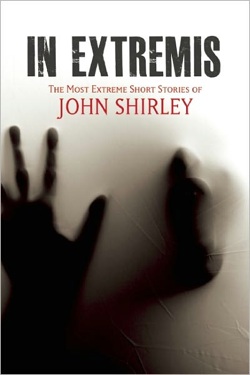Author John Shirley has been writing for print, film, TV and video games for several decades and while his medium may change from project to project, his focus remains largely on the darker side of life. Considered an early influence in the cyberpunk and splatterpunk movements, Shirley’s City Come-a-Walkin’ and A Song of Youth trilogy brought him early acclaim. He’s collaborated on short stories with William Gibson and Bruce Sterling. He wrote the initial script for The Crow as well as scripts for Deep Space Nine. His 1998 collection Black Butterflies won the Bram Stoker and IHG Awards that year. Lately, in addition to producing original works, Shirley’s been writing a slew of media tie-novels including Doom and Bioshock: Rapture.??
For an author whose overall work can already be considered a bit extreme in nature, the stories collected here are most definitely not for everyone. For some, myself included, the word “extreme” has some negative connotations due to overuse in marketing-speak. “Extreme” sports fans and “extreme” Doritos aren’t exactly as edgy and in your face as they claim to be. Shirley’s writing doesn’t really get in your face so much as it gets under your skin. Sure, some of the stories in In Extremis are pretty blunt (“You Blundering Idiot, You Fucking Failed to Kill Me Again!”) but for the most part, these are tales of insidious evil creeping into our world, malevolent forces from Outside or within guiding hands to nefarious ends, and a motley assortment of walking tragedies.
??My favorite story in the collection is, hands-down, “Cram.” On the surface, it’s a story about a bike messenger trapped underground on a crowded BART train during an earthquake. It is one of the most harrowing reads I’ve ever experienced. It’s a fight for survival, a fight against death, impossibly sad and, strangely, beautiful in its final execution. I first read this story in Black Butterflies about ten years ago and it still sometimes comes to mind when I’m commuting on the subway. Every now and then, the car screeches to a sudden stop, the lights flicker and I sit in terror for a moment, looking at the passengers around me and wonder if this could be the moment when everything changes, that we will all become connected in the most human, most personal, of ways. Then the train rumbles back to life and I go back to listening to my music and wishing the large guy spilling over into my personal space would get off at the next stop. (Yeah, this isn’t a great story for anxious people.)??
The stories that worked best for me in this collection are the ones where the horror is more human than not. Shirley writes of addicts, pushers, pimps, and prostitutes with a kind of authentic voice that can only come from having been there. This isn’t the gaudy, glamorized addiction of designer highs and sexy nightclub scenes. No heroin-chic here. These are some of the saddest, grossest kinds of junkies. Shirley paints a vivid and humane portrait of human need with equal parts sympathy and wry humor. Witness an escort answer a strange personal ad in “‘I Want to Get Married,’ says the World’s Smallest Man.” Or flip-sides of a similar exchange, ghastly and funny in “Just Like Suzie” and chilling and tense in “Tighter.” Yeah, there’s a definite fascination with prostitutes here. Better is “Ten Things To Be Grateful For,” a list of nine tableaux that paint intimate portraits of men, women, and children in too-plausible terror with a punchline at the end that provokes thought as well as a chuckle.
??Not all of the jokes and social commentary work so well. Despite being updated for the times, some of the West Coast slang still sounds dated and the new pop culture references seem almost jarring in the text. “Gotterdammergun” and “The Exquisitely Bleeding Heads of Doktur Palmer Vreedeez” are especially guilty of this.The collection is organized in such a way that stories with very similar themes come one right after the other, and if you’re not feeling it, reading becomes tedious. But, mostly, I don’t read story collections in order. Perhaps I’m supposed to—albums are arranged deliberately; I know the editor and author ordered these stories this particular way for a reason—but the beauty of short stories is that they’re usually self-contained. I can only think of one collection that is better read in the author’s preferred order, the gorgeous dark fantasy collection Tales of Pain and Wonder by Caitlin R. Kiernan.)
Horror fiction has waned considerably since Shirley started publishing, but In Extremis proves that true horror authors can see the shock and sickness in any situation, no matter the scenario. Shirley’s stories are just as versatile as his career, crossing genres and boundaries with delight.
Theresa DeLucci is an graduate of the Clarion West Writers’ Workshop of 2008. Her fiction has appeared in ChiZine, Morbid Outlook, and Tear magazine.










